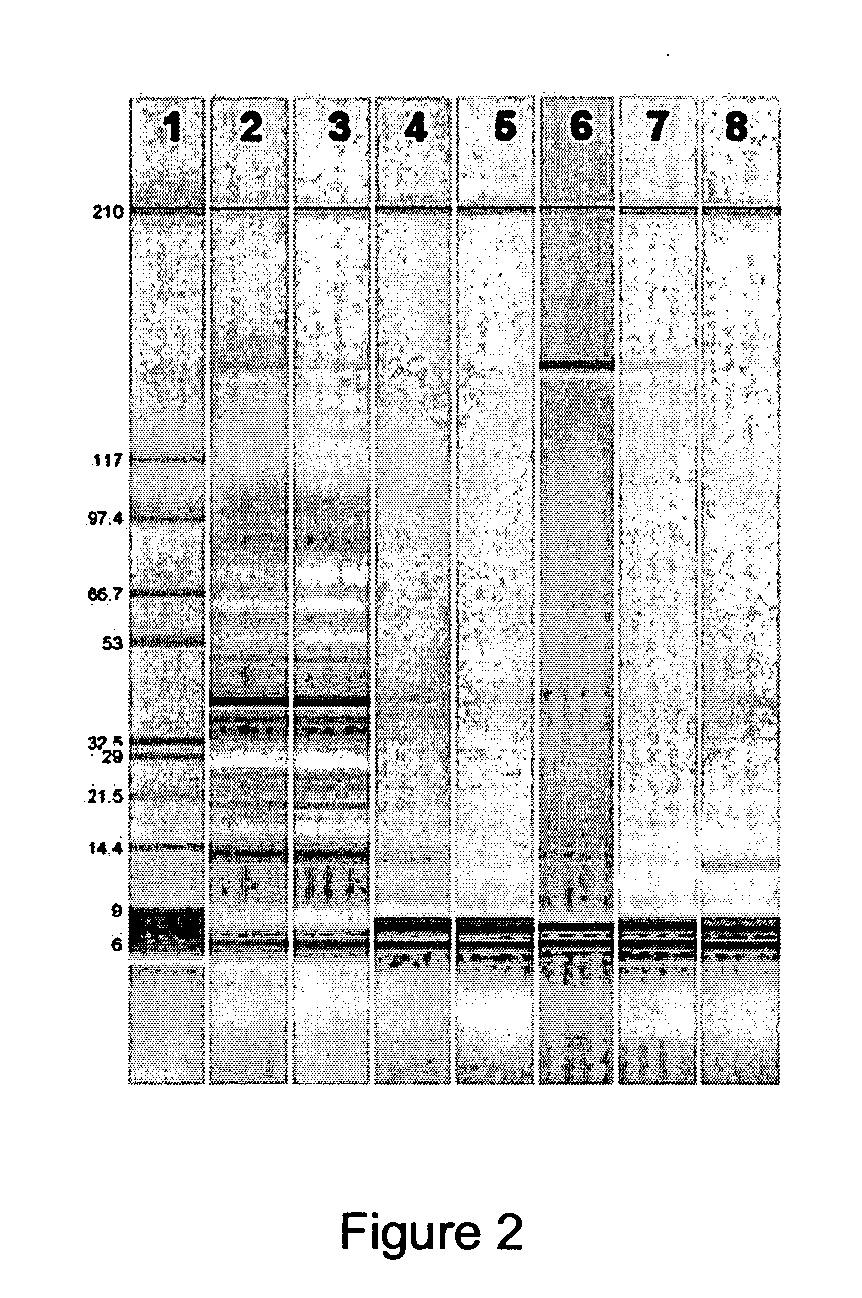Method for purifying and recovering silk proteins using magnetic affinity separation
a technology of magnetic affinity and silk protein, which is applied in the direction of peptide/protein ingredients, peptide sources, peptides, etc., can solve the problems of significant product loss, labor-intensive and time-consuming silk production from silkworms and cultivated spiders, and complex purification of recombinant spider silk proteins from microbial sources
- Summary
- Abstract
- Description
- Claims
- Application Information
AI Technical Summary
Benefits of technology
Problems solved by technology
Method used
Image
Examples
example 1
Purification and Recovery of Spider Silk Analog Protein DP-2A Using Ferrite Magnetic Particles
[0112] The purpose of this Example was to demonstrate the recovery and purification of spider silk analog protein DP-2A using ferrite magnetic particles. The spider silk analog protein DP-2A was expressed in E. coli and was recovered and purified using magnetic affinity separation.
Production of Spider Silk Analog Protein DP-2A in E. coli:
[0113]E. coli strain FP3276 designed for the production of spider silk analog protein DP-2A (SEQ ID NO:4) as described by Fahnestock in U.S. Pat. No. 6,268,169, (incorporated herein by reference), was cultured as described in Example 5 of U.S. Pat. No. 6,268,169 (incorporated herein by reference) with minor modifications as follows. This spider silk protein analog was designed to contain six consecutive histidine residues (6×His tag) at the C-terminus for purification by metal chelate affinity techniques. Strain FP3276 was grown at 36° C. in a BioLafitt...
example 2
Purification and Recovery of Spider Silk Analog Protein DP-2A Using Polyvinyl Alcohol-Coated Magnetic Particles
[0124] The purpose of this Example was to demonstrate the recovery and purification of spider silk analog protein DP-2A using polyvinyl alcohol (PVA)-coated magnetic particles. The spider silk analog protein DP-2A was expressed in E. coli and was recovered and purified using magnetic affinity separation.
Production of Spider Silk Analog Protein DP-2A in E. coli:
[0125] The spider silk analog protein DP-2A was prepared as described in Example 1.
Preparation of PVA-Coated Magnetic Particles:
[0126] Unfunctionalized magnetic polyvinyl alcohol (PVA) particles “M-PVA 01x” were purchased from Chemagen (Chemagen Biopolymer-Technologie AG, Baesweiler, Germany). Iminodiactetic acid (IDA) was covalently bound to the PGA-coated magnetic particles by a three-step reaction scheme. These reaction steps consisted of an allyl-activation step, a bromination step and the IDA coupling step...
example 3
Investigation of the Effect of the Protein to Particle Ratio on the Purification of Spider Silk Protein Analog DP-2A
[0131] The purpose of this Example was to investigate the effect of the protein to particle ratio on the purification of spider silk analog protein DP-2A. The protein to particle ratio was varied from 4 to 32 mg of the spider silk analog protein per gram particle dry weight of the PVA-coated magnetic particles.
[0132] Spider silk analog protein DP-2A was produced as described in Example 1. The resulting crude silk protein extract was diluted to give a DP-2A protein concentration of 162 mg / L. The PVA-coated magnetic particles were prepared as described in Example 2. A series of purifications was carried out as described in Example 1 using protein to particle ratios of 4, 8, 16, and 32 mg of spider silk analog protein per gram dry weight of the PVA-coated magnetic particles. The DP-2A protein was eluted in a fifth of the volume (0.1 mL) compared to the volume in the ads...
PUM
| Property | Measurement | Unit |
|---|---|---|
| diameter | aaaaa | aaaaa |
| diameter | aaaaa | aaaaa |
| diameter | aaaaa | aaaaa |
Abstract
Description
Claims
Application Information
 Login to View More
Login to View More - R&D
- Intellectual Property
- Life Sciences
- Materials
- Tech Scout
- Unparalleled Data Quality
- Higher Quality Content
- 60% Fewer Hallucinations
Browse by: Latest US Patents, China's latest patents, Technical Efficacy Thesaurus, Application Domain, Technology Topic, Popular Technical Reports.
© 2025 PatSnap. All rights reserved.Legal|Privacy policy|Modern Slavery Act Transparency Statement|Sitemap|About US| Contact US: help@patsnap.com


